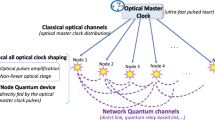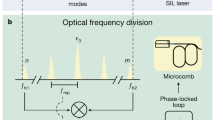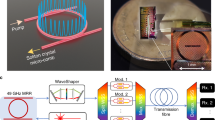Abstract
Precision optical-frequency and phase synchronization over fibre is critical for a variety of applications, from timekeeping to quantum optics. Such applications utilize ultra-coherent sources based on stabilized table-top laser systems. Chip-scale versions of these systems may dramatically broaden the application landscape by reducing the cost, size and power of such exquisite sources. Links based on the required narrow-linewidth integrated lasers, compact reference cavities and control methodologies have not yet been presented. Here, we demonstrate an optically synchronized link that achieves an ultralow residual phase error variance of 3 × 10−4 rad2 at the receiver, using chip-scale stabilized lasers with laser linewidth of ~30 Hz and instability below 2 × 10−13 at 50 ms. This performance is made possible with integrated Brillouin lasers, compact reference cavities and a novel low-bandwidth optical-frequency-stabilized phase-locked loop. These results demonstrate a path towards low-power, precision applications including distributed atomic clocks, quantum links, database synchronization and digital-signal-processor-free coherent fibre interconnects.
This is a preview of subscription content, access via your institution
Access options
Access Nature and 54 other Nature Portfolio journals
Get Nature+, our best-value online-access subscription
$29.99 / 30 days
cancel any time
Subscribe to this journal
Receive 12 print issues and online access
$209.00 per year
only $17.42 per issue
Buy this article
- Purchase on Springer Link
- Instant access to full article PDF
Prices may be subject to local taxes which are calculated during checkout




Similar content being viewed by others
Data availability
The data that support the plots within this paper and other findings of this study are available from the corresponding author on reasonable request.
References
Ma, L.-S., Jungner, P., Ye, J. & Hall, J. L. Delivering the same optical frequency at two places: accurate cancellation of phase noise introduced by an optical fiber or other time-varying path. Opt. Lett. 19, 1777–1779 (1994).
Hall, J. L. & Zhu, M. in International School of Physics Enrico Fermi Course CXVII, Laser Manipulation of Atoms and Ions (eds Arimondo, E. et al.) 671–702 (North Holland, 1993).
Foreman, S. M. et al. Coherent optical phase transfer over a 32-km fiber with 1-s instability at 10−17. Phys. Rev. Lett. 99, 153601 (2007).
Calonico, D. et al. High-accuracy coherent optical frequency transfer over a doubled 642-km fiber link. Appl. Phys. B 117, 979–986 (2014).
Roberts, B. M. et al. Search for transient variations of the fine structure constant and dark matter using fiber-linked optical atomic clocks. New J. Phys. 22, 093010 (2020).
Clivati, C. et al. A coherent fiber link for very long baseline interferometry. IEEE Trans. Ultrason. Ferroelectr. Freq. Control 62, 1907–1912 (2015).
Grotti, J. et al. Geodesy and metrology with a transportable optical clock. Nat. Phys. 14, 437–441 (2018).
Lisdat, C. et al. A clock network for geodesy and fundamental science. Nat. Commun. 7, 12443 (2016).
Fujieda, M. et al. All-optical link for direct comparison of distant optical clocks. Opt. Express 19, 16498–16507 (2011).
Riehle, F. Optical clock networks. Nat. Photon. 11, 25–31 (2017).
Nakazawa, M., Hirooka, T., Yoshida, M. & Kasai, K. in Optical Fiber Telecommunications 6th edn (eds Kaminow, I. P. et al.) 297–336 (Academic Press, 2013).
Kessler, T. et al. A sub-40-mHz-linewidth laser based on a silicon single-crystal optical cavity. Nat. Photon. 6, 687–692 (2012).
Matei, D. G. et al. 1.5-μm lasers with sub-10-mHz linewidth. Phys. Rev. Lett. 118, 263202 (2017).
Pillai, B. S. G. et al. End-to-end energy modeling and analysis of long-haul coherent transmission systems. J. Lightw. Technol. 32, 3093–3111 (2014).
Crivelli, D. E. et al. Architecture of a single-chip 50-Gb/s DP-QPSK/BPSK transceiver with electronic dispersion compensation for coherent optical channels. IEEE Trans. Circuits Syst. Regul. Pap. 61, 1012–1025 (2014).
Laperle, C. & O’Sullivan, M. Advances in high-speed DACs, ADCs and DSP for optical coherent transceivers. J. Lightw. Technol. 32, 629–643 (2014).
Corbett, J. C. et al. Spanner: Google’s globally-distributed database. In OSDI (2012) 251–264 (USENIX Association, 2012).
Dierikx, E. F. et al. White rabbit precision time protocol on long-distance fiber links. IEEE Trans. Ultrason. Ferroelectr. Freq. Control 63, 945–952 (2016).
Schediwy, S. W., Gozzard, D. R., Stobie, S., Malan, J. A. & Grainge, K. Stabilized microwave-frequency transfer using optical phase sensing and actuation. Opt. Lett. 42, 1648–1651 (2017).
Brodnik, G. M. et al. Chip-scale, optical-frequency-stabilized PLL for DSP-free, low-power coherent QAM in the DCI. In Optical Fiber Communication Conference (OFC) 2020 M3A.6 (OSA, 2020).
Blumenthal, D. J. et al. Frequency-stabilized links for coherent WDM fiber interconnects in the datacenter. J. Lightw. Technol. 38, 3376–3386 (2020).
Kikuchi, K. Fundamentals of coherent optical fiber communications. J. Lightw. Technol. 34, 157–179 (2016).
Perin, J. K., Shastri, A. & Kahn, J. M. Design of low-power DSP-free coherent receivers for data center links. J. Lightw. Technol. 35, 4650–4662 (2017).
Kazovsky, L. G. Balanced phase-locked loops for optical homodyne receivers: performance analysis, design considerations and laser linewidth requirements. J. Lightw. Technol. 4, 182–195 (1986).
Satyan, N. Phase noise reduction of a semiconductor laser in a composite optical phase-locked loop. Opt. Eng. 49, 124301 (2010).
Balakier, K., Ponnampalam, L., Fice, M. J., Renaud, C. C. & Seeds, A. J. Integrated semiconductor laser optical phase lock loops. IEEE J. Sel. Top. Quantum Electron. 24, 1–12 (2018).
Simsek, A. et al. Evolution of chip-scale heterodyne optical phase-locked loops toward Watt level power consumption. J. Lightw. Technol. 36, 258–264 (2018).
Park, H. et al. 40-Gbit/s coherent optical receiver using a Costas loop. Opt. Express 20, 9736–9741 (2012).
Drever, R. W. P. et al. Laser phase and frequency stabilization using an optical resonator. Appl. Phys. B Photophys. Laser Chem. 31, 97–105 (1983).
Liang, W. et al. Ultralow noise miniature external cavity semiconductor laser. Nat. Commun. 6, 7371 (2015).
Loh, W. et al. Dual-microcavity narrow-linewidth Brillouin laser. Optica 2, 225–232 (2015).
Lee, H. et al. Spiral resonators for on-chip laser frequency stabilization. Nat. Commun. 4, 2468 (2013).
Zhang, W. et al. Ultranarrow linewidth photonic-atomic laser. Laser Photon. Rev. 14, 1900293 (2020).
Gundavarapu, S. et al. Sub-hertz fundamental linewidth photonic integrated Brillouin laser. Nat. Photon. 13, 60–67 (2019).
Morton, P. A. & Morton, M. J. High-power, ultra-low noise hybrid lasers for microwave photonics and optical sensing. J. Lightw. Technol. 36, 5048–5057 (2018).
Debut, A., Randoux, S. & Zemmouri, J. Linewidth narrowing in Brillouin lasers: theoretical analysis. Phys. Rev. A 62, 023803 (2000).
Loh, W. et al. A microrod-resonator Brillouin laser with 240-Hz absolute linewidth. New J. Phys. 18, 045001 (2016).
Matsko, A. B., Savchenkov, A. A., Yu, N. & Maleki, L. Whispering-gallery-mode resonators as frequency references. I. Fundamental limitations. J. Opt. Soc. Am. B 24, 1324–1335 (2007).
Schilt, S. et al. Frequency discriminators for the characterization of narrow-spectrum heterodyne beat signals: application to the measurement of a sub-hertz carrier-envelope-offset beat in an optical frequency comb. Rev. Sci. Instrum. 82, 123116 (2011).
Di Domenico, G., Schilt, S. & Thomann, P. Simple approach to the relation between laser frequency noise and laser line shape. Appl. Opt. 49, 4801–4807 (2010).
Nazarathy, M., Sorin, W. V., Baney, D. M. & Newton, S. A. Spectral analysis of optical mixing measurements. J. Lightw. Technol. 7, 1083–1096 (1989).
Kazovsky, L. G. & Atlas, D. A. A 1,320-nm experimental optical phase-locked loop: performance investigation and PSK homodyne experiments at 140 Mb/s and 2 Gb/s. J. Lightw. Technol. 8, 1414–1425 (1990).
Sluyski, M. A., Gass, K. & Stauffer, D. R. Implementation Agreement 400ZR OI-400ZR-01.0 (Optical Internetworking Forum, 2020).
Ip, E., Lau, A. P. T., Barros, D. J. F. & Kahn, J. M. Coherent detection in optical fiber systems. Opt. Express 16, 753–791 (2008).
Duan, L. General treatment of the thermal noises in optical fibers. Phys. Rev. A 86, 023817 (2012).
Idjadi, M. H. & Aflatouni, F. Nanophotonic phase noise filter in silicon. Nat. Photon. 14, 234–239 (2020).
Blumenthal, D. J., Heideman, R., Geuzebroek, D., Leinse, A. & Roeloffzen, C. Silicon nitride in silicon photonics. Proc. IEEE 106, 2209–2231 (2018).
Komljenovic, T. et al. Photonic integrated circuits using heterogeneous integration on silicon. Proc. IEEE 106, 2246–2257 (2018).
Brodnik, G. M. et al. Ultra-narrow linewidth chip-scale heterogeneously integrated silicon/III–V tunable laser pumped Si/Si3N4 SBS laser. In Conference on Lasers and Electro-Optics, OSA Technical Digest STu3M.5 (Optical Society of America, 2020).
Huang, D. et al. High-power sub-kHz linewidth lasers fully integrated on silicon. Optica 6, 745–752 (2019).
Zhao, Q. et al. Low-loss low thermo-optic coefficient Ta2O5 on crystal quartz planar optical waveguides. APL Photonics 5, 116103 (2020).
Puckett, M. W. et al. 422 million intrinsic quality factor planar integrated all-waveguide resonator with sub-MHz linewidth. Nat. Commun. 12, 934 (2021).
Harrington, M. W. et al. Kerr soliton microcomb pumped by an integrated SBS laser for ultra-low linewidth WDM sources. In Optical Fiber Communication Conference (OFC) 2020 T4G.6 (OSA, 2020); https://doi.org/10.1364/OFC.2020.T4G.6
Gardner, F. M. Phaselock Techniques 3rd edn (Wiley, 2005).
Acknowledgements
This research was supported by the OPEN 2018 Advanced Research Projects Agency–Energy (ARPA-E), US Department of Energy, under award no. DE-AR0001042. The views and conclusions contained in this document are those of the authors and should not be interpreted as representing official policies of ARPA-E or the US Government.
Author information
Authors and Affiliations
Contributions
G.M.B., D.J.B. and S.B.P. prepared the manuscript. D.J.B. conceived the OFS-PLL approach. D.J.B., G.M.B., M.W.H. and S.B.P. conceived the implemented OFS-PLL architecture. P.A.M. contributed the narrow-linewidth integrated optical pump sources. D.B. fabricated the SiN integrated high-Q resonator SBS laser chip. W.Z., L.S. and S.B.P. contributed the optical cavity used in the SBS laser stabilization stage. G.M.B. and M.W.H. performed the experiments, including SBS generation, SBS stabilization to cavities and optical phase locking along with the associated noise and performance characterizations. J.H.D. and R.O.B. contributed simulations of laser noise, fibre noise and performance and identification of noise contributions from SBS and cavity stabilization physics theory. All authors contributed to analysing the simulated and experimental results. D.J.B. and S.B.P. supervised and led the scientific collaboration.
Corresponding author
Ethics declarations
Competing interests
The authors declare no competing interests.
Additional information
Peer review information Nature Photonics thanks the anonymous reviewers for their contribution to the peer review of this work.
Publisher’s note Springer Nature remains neutral with regard to jurisdictional claims in published maps and institutional affiliations.
Supplementary information
Supplementary Information
Supplementary Information, including six sections of discussion, five figures, one table and 16 references.
Rights and permissions
About this article
Cite this article
Brodnik, G.M., Harrington, M.W., Dallyn, J.H. et al. Optically synchronized fibre links using spectrally pure chip-scale lasers. Nat. Photon. 15, 588–593 (2021). https://doi.org/10.1038/s41566-021-00831-w
Received:
Accepted:
Published:
Issue Date:
DOI: https://doi.org/10.1038/s41566-021-00831-w
This article is cited by
-
Frequency-selective perovskite photodetector for anti-interference optical communications
Nature Communications (2024)
-
A double-tapered fibre array for pixel-dense gamma-ray imaging
Nature Photonics (2023)
-
Communications with guaranteed bandwidth and low latency using frequency-referenced multiplexing
Nature Electronics (2023)
-
High-performance lasers for fully integrated silicon nitride photonics
Nature Communications (2021)



